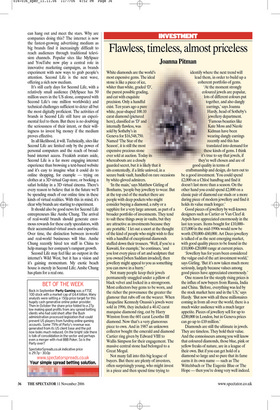Flawless, timeless, almost priceless
White diamonds are the world’s most expensive gems. The ideal stone is like a piece of ice, whiter than white, graded ‘D’, the purest possible grading, and cut with exquisite precision. Only a handful exist. Ten years ago a pure white, pear-shaped 100.10 carat diamond (pictured here), classified as ‘D’ and internally flawless, was sold by Sotheby’s in Geneva for $16,548,750.
Named ‘The Star of the Season’, it is still the most expensive precious stone ever sold at auction. Today its whereabouts are a closely guarded secret, but it is likely that it sits contentedly, if a little unloved, in a secure bank vault, handled on rare occasions by white-gloved admirers.
‘In the main,’ says Matthew Girling of Bonhams, ‘people buy jewellery to wear. But at the top end of the market there are people with deep pockets who might consider buying a diamond, a ruby or a sapphire for a very large amount, as part of a broader portfolio of investments. They tend to salt these things away in vaults, but they are attractive as investments because they are portable.’ I let out a snort at the thought of the kind of people who might wish to flee with a handful of exceptional diamonds stuffed down their trousers. ‘Well, if you’re a Kuwaiti, for example,’ he continues, ‘and you lost every piece of art and sculpture that you owned [when Saddam invaded], then jewellery might appeal to you as something you can move in a hurry.’ Not many people keep their jewels permanently snuggled under a pillow of black velvet and locked in a strongroom. Most collectors buy gems to be worn, and the richer the provenance the greater the glamour that rubs off on the wearer. When Jacqueline Kennedy Onassis’s jewels were sold in 1996, they included a 40.42 carat marquise diamond ring, cut by Harry Winston from the 601 carat Lesotho III diamond. Now that’s a very glamorous piece to own. And in 1987 an unknown collector bought the emerald and diamond Cartier ring given by Edward VIII to Wallis Simpson for their engagement. The massive central stone had belonged to a Great Mogul.
Not many fall into this big league of buyers. But there are plenty of investors, often surprisingly young, who might invest in a piece and then spend time trying to identify where the next trend will lead them, in order to build up a coherent portfolio of gems. ‘At the moment strongly coloured jewels are popular, lots of different colours put together, and also dangly earrings,’ says Joanna Hardy, head of Sotheby’s jewellery department. ‘Famous beauties like Kate Moss and Nicole Kidman have been wearing dangly earrings recently and this has translated into demand for these kinds of gems. I think it’s true to say that jewels, if they’re well chosen and are of good quality in terms of craftsmanship and design, do turn out to be a good investment. You could spend £2,000 on a Chloé handbag and find it doesn’t last more than a season. On the other hand you could spend £2,000 on a classic pair of diamond ear studs or a more daring piece of modern jewellery and find it holds its value much longer.’ Good pieces of jewellery by well-known designers such as Cartier or Van Cleef & Arpels have appreciated enormously in the last ten years. Items bought for £10,000– £15,000 in the mid-1990s would now be worth £50,000–£60,000. Art Deco jewellery is talked of as the next emerging market, with good quality pieces to be found in the £10,000–£20,000 range at current prices.
‘Jewellery has for years been considered the vulgar end of the art investment world,’ says Girling. ‘But it’s now taken much more seriously, largely because values among good pieces have appreciated enormously.’ One reason for the steeply rising prices is the influx of new buyers from Russia, India and China. ‘Before, everything was led by the stock market here and in the US,’ says Hardy. ‘But now with all these millionaires coming in from all over the world, there is a much wider audience with a much larger appetite. Pieces of jewellery sell for up to £200,000 in London, but in Geneva prices can go up to £10 million.’ Diamonds are still the ultimate in jewels. They are timeless. They hold their value. And the connoisseurs among you will know that coloured diamonds, those blue, pink or yellow freaks of nature, are in a league of their own. But if you can get hold of a diamond so large and so pure that its fame earns it its own name — such as The Wittelsbach or The Eugenie Blue or The Hope — then you’re doing very well indeed.


































































































 Previous page
Previous page